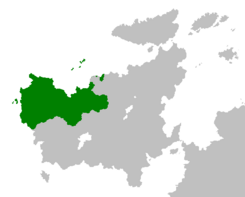Duchy of Pavatria
This article is incomplete because it is pending further input from participants, or it is a work-in-progress by one author. Please comment on this article's talk page to share your input, comments and questions. Note: To contribute to this article, you may need to seek help from the author(s) of this page. |
Duchy of Pavatria Герцогство Паватрія Hertsohstvo Pavatriya Pavatuan herttuakunta | |||||||||
|---|---|---|---|---|---|---|---|---|---|
| 910–1454 | |||||||||
 Pavatria at its greatest extent in Euclea in 1440, shortly after the Iconoclast Wars. | |||||||||
| Capital | Patovatra | ||||||||
| Common languages | Soravian, Zalyk, Vichod, Miersan | ||||||||
| Religion | Episemialist Church | ||||||||
| Demonym(s) | Pavatrian | ||||||||
| Government | Absolute monarchy | ||||||||
| Duke | |||||||||
• 910–946 | Nuruk | ||||||||
• 1007–1020 | Oleg I | ||||||||
• 1179–1191 | Tomislav | ||||||||
• 1277–1321 | Nikolai IV | ||||||||
• 1377–1408 | Ivan II | ||||||||
• 1443–1454 | Jan II | ||||||||
| Legislature | None centralised; multiple local veches | ||||||||
| Historical era | Medieval | ||||||||
• Established | 910 | ||||||||
| 939 | |||||||||
| August 28, 1286 | |||||||||
| 1409–1441 | |||||||||
• Reformed into Archduchy of Soravia | May 18, 1454 | ||||||||
| Area | |||||||||
| 1440 | 1,800,000 km2 (690,000 sq mi) | ||||||||
| Population | |||||||||
• 1440 | 3,100,000 | ||||||||
| Currency | hertso, korol | ||||||||
| |||||||||
| Today part of | East Miersa Soravia Laudania Ravnia Vedmed Velzemia West Miersa | ||||||||
The Duchy of Pavatria (Soravian: Герцогство Паватрія; Hertsohstvo Pavatriya) or simply just Pavatria was a state centred in modern-day Soravia that was the primary medieval successor entity of the principalities of the Great Vesemir. It was established by Nuruk in 910 AD as a collective unification of the Vesemir principalities north of the Ostrug mountains. Initially centralised for defense purposes, with high autonomy, the state eventually expanded and grew into a centralised state over the 10th century. At its height, it spanned nearly 2 million square kilometres, and was the largest state in Euclea by land area of its era.
Nuruk converted to Sotirianity in 939 when he was baptised by Amathian-Piraean missionary Hippodalia, which legitimised the state particularly among the Arcilucan Episemialist clergy and administrators, who served as the main bridge between east and west Euclea. Pavatria fought multiple wars against the Zalyk Khanate after the Tagamic migrations that lasted around 200 years and ended with the Battle of Usaanbalsan in 1286, in which Nikolai of Lipa usurped Ayuga Khan and crowned himself Khan of Zalykia, bringing the two states into personal union. Pavatria had complex geopolitical relations with its main geopolitical rival, the Empire of Tengaria, throughout the 14th century. Due to their distance, this never resulted in any formal conflict. Pavatria was a major combatant in the Iconoclast Wars in the early part of the 15th century, fighting against iconoclast forces concentrated mainly in Ravnia, eventually gaining some land concessions as the policy of cuius egio, eius religio was implemented among the Episemialist nations. Increased centralisation and elevation to a major position of power with the decline of Tengaria saw the state reformed into the Archduchy of Soravia in 1454.

